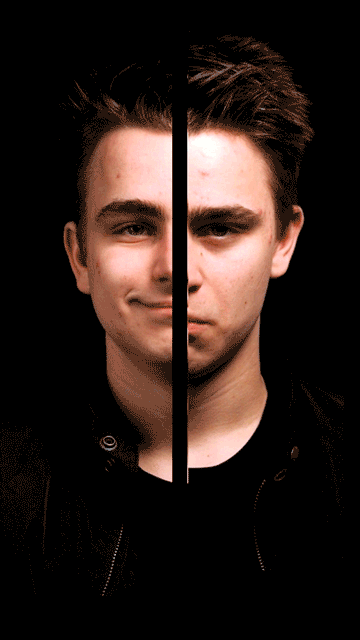About
Uncanny celebrates the faces we make in between expressions, the faces that – when captured in a photograph, “just feel wrong”.
Steps were taken to ensure an unnerving and uncanny result without simply distorting, coloring, or any other such “easy” approaches that work between the expression and the interpretation.
This “portrait machine” is designed to emphasize the uncanniness that arises from the expressions the subject makes, not to inject uncanniness into a portrait.
Process
The following steps were taken to emphasize the uncanny expressions:
- The video was captured at about 700 frames per second, at 720p. A regular video allows a video to ignore the uncanny expressions unconsciously, as we do all the time. Images are too easily “written off” in my opinion as just a “weird face”. The video tells hints a story of the intended expression.
- The video is vertical, not widescreen, making it more difficult for an audience to simply ‘rest’ their eyes on one element.
- The subject was not permitted to relax during the shoot, not sit in a chair with a back. Uncomfortable, confusing, and off-putting questions were asked, as well as the use of deliberately off-putting use of uncomfortable silences, volume changes, and other anti-social behavior during the shoot. The subject never “loosened up” in front of the camera.
- Multiple images on the screen are juxtaposed. They are not blended and bordered, signaling the viewer to switch attention between the various sections. The viewer attempts to assemble a single expression from these parts, and the parts – either temporally, geometrically, or with the expression – are not aligned.
The following steps were taken while working with the challenging tools.
- Only one continuous (no flicker) light was available, so a clever lighting setup had to be employed with a reflector, and black backdrop.
- Significant color grading was employed to normalize the camera’s unfiltered color cast.
- Video intake, tagging, organizing, and editing was not experimental, but the most time consuming part of the process. Among the normal time consuming tasks, frequent breaks were necessary during editing to get a ‘fresh look’ at the footage, as one quickly gets used to the uncanny effect that the video aims to achieve.
- Full screen preview of the image was necessary to check focus and composition, which constricted the shooting environment by cable length, desk placement, and so on.
- Image tracking and digital image stabilization was utilized to keep the face elements consistent despite head movement.
Success and Failures
This project was successful in achieving one of my secret goals: using the high speed camera for a project that uses a high speed footage and 1) doesn’t sacrifice production value and 2) doesn’t look like high speed footage – the aesthetic often found with a single close hard light, quick shadow falloff, discoloration, and – of course – boring.
The original goal, to capture the moments as a laugh slides through a natural smile into a false, fake smile, was achieved in the capture process (link coming soon), but the video result is 1) extremely boring, 2) too similar to Warhol’s screen tests for my taste and 3) did not hold up as a triptych in my opinion. Uninspired, I took a step back, considered the goals – the uncanny expressions being my true capture goal – and continued forward with the project under this refreshed lens.
The biggest failure was something I discovered while editing – I should have shot close ups, and combined different visual angles. The form of the project evolved while editing, and I was unable to re-shoot in order to better capture what I wished to achieve.
The other biggest failure was the inability, for a variety of reasons, to just play with the high speed camera. I knew from experience with the camera that to achieve a quality result I had to have a plan and execute on it. Different camera settings, lighting setups, angles, and so forth were completely impractical to achieve. I would love to spend more time with the camera, as I believe it can achieve beautiful results when used well – but it’s slow (ha) and awkward to deal with.
